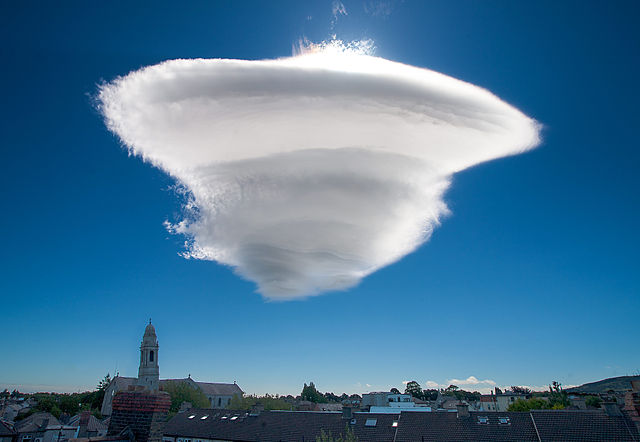Lenticular clouds, often referred to as “lennies,” are a unique and visually striking cloud formation that resembles saucer-shaped or lens-like clouds. They are typically associated with mountainous regions and are caused by specific atmospheric conditions. Here’s a glimpse into the science behind lenticular cloud formation:
Formation:
- Orographic Lift: Lenticular clouds are primarily formed by orographic lift, a process in which air is forced to rise over elevated terrain, such as mountains or hills.

- Stable Air Mass: For lenticular clouds to form, the air mass needs to be stable, meaning that it resists vertical movement. Stable air is relatively cool and has a stratified, layered structure.
- Moisture Content: Lenticular clouds often form at high altitudes where the air is cold and moist. The presence of moisture is crucial for cloud formation.
- Wind Flow: Wind flow is a key factor. As air encounters a mountain range, it is forced to ascend. When this air rises, it cools and may reach its dew point temperature, causing water vapor to condense into cloud droplets.
Characteristics:
- Saucer or Lens Shape: Lenticular clouds have a distinct saucer or lens shape, which is their most recognizable feature. They often appear as smooth, elongated, and stacked cloud layers with a characteristic wave-like appearance.
- Stability and Layering: These clouds maintain their shape because the air at the altitude where they form is stable and tends to resist vertical motion. The layers of air above and below the cloud act like a “lens” that traps the moisture.
- Constant Position: Lenticular clouds remain relatively stationary in relation to the mountain or obstacle causing their formation. They can appear to hover or float in place, even in the presence of strong winds.
- Smooth Edges: Lenticular clouds have smooth, well-defined edges and typically lack the ragged appearance of many other cloud types.
Optical Effects:
Lenticular clouds often produce optical effects due to their unique shape and position in the sky:
- Iridescent Colors: The smooth, layered structure of lenticular clouds can sometimes create iridescent colors along their edges. This phenomenon occurs when sunlight is diffracted or scattered by the tiny cloud droplets.
- Glories: Glories are colorful, circular rings or halos that can appear around the shadow of an object (like an aircraft) when viewed from above the cloud layer.
Meteorological Significance:
Lenticular clouds are often associated with good flying conditions for pilots, as they indicate stable air masses. However, they can also signal the presence of strong winds aloft, which can be a concern for aviation.
In summary, lenticular clouds are formed by orographic lift, stable air masses, moisture, and wind flow. Their saucer or lens shape is distinctive, and they are known for their unique optical effects. Understanding the science behind lenticular cloud formation is essential for pilots, meteorologists, and anyone who appreciates the beauty of these captivating cloud formations.











